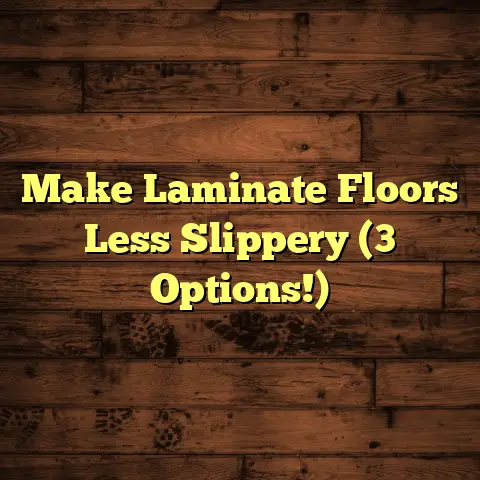What To Use For Tile? (3 Fixes Inside!)
As a flooring contractor for over 15 years, I’ve seen it all when it comes to tile. And let me tell you, picking the right tile isn’t just about aesthetics; it’s about your wallet, both now and down the road.
We all want that stunning kitchen backsplash or that spa-like bathroom floor, but let’s be real: nobody wants to break the bank.
That’s why cost-effectiveness is king (or queen!) when choosing tiling materials. The tile you choose can massively impact your upfront costs, but also those sneaky long-term maintenance expenses. Think about it: are you prepared to reseal natural stone every year?
Or would you rather opt for something more low-maintenance? Today, I’m going to walk you through three solid tile options that balance beauty, durability, and, most importantly, affordability.
We’ll dive deep into ceramic, vinyl, and natural stone tiles, giving you the inside scoop on costs, benefits, installation tips, and potential drawbacks.
Ready to get started? Let’s jump in!
Section 1: Fix #1 – Ceramic Tiles
Overview of Ceramic Tiles
What exactly are ceramic tiles?
Simply put, they’re made from clay that’s been fired at high temperatures. You’ll find them everywhere: floors, walls, kitchens, bathrooms – you name it.
Ceramic tiles are a classic for a reason. They’re versatile and relatively inexpensive compared to other options.
Cost Breakdown
Alright, let’s talk numbers. Ceramic tiles come in a wide range of prices, depending on the type, design, and size.
Generally, you can expect to pay anywhere from $0.50 to $15 per square foot for the tiles themselves.
- Glazed vs. Unglazed: Glazed tiles tend to be slightly more expensive due to the added layer of protection and design. Expect to pay $1 to $10 per square foot for glazed, while unglazed can range from $0.50 to $7.
- Standard vs. Designer: Designer tiles, with intricate patterns or unique shapes, can easily reach the higher end of that range, or even exceed it.
Now, let’s not forget about installation. Unless you’re a seasoned DIYer, you’ll likely need to factor in labor costs. Professional installation can add another $4 to $10 per square foot.
Then there’s the cost of thin-set mortar, grout, and sealant, which can add another $0.50 to $2 per square foot.
Over time, maintenance is relatively minimal. You’ll need to clean them regularly with a mild detergent, and you might need to re-grout every 10-15 years, which can cost around $1 to $3 per square foot.
Here’s a table summarizing the cost breakdown:
| Expense | Cost per Square Foot | Notes |
|---|---|---|
| Tile (Glazed) | $1 – $10 | Varies depending on design and quality. |
| Tile (Unglazed) | $0.50 – $7 | More affordable option. |
| Installation | $4 – $10 | Can be higher for complex patterns or large format tiles. |
| Materials | $0.50 – $2 | Thin-set mortar, grout, sealant. |
| Maintenance (Regrouting) | $1 – $3 | Every 10-15 years |
Benefits of Ceramic Tiles
Why choose ceramic? Let me count the ways:
- Durability: Ceramic tiles are tough cookies. They can withstand a lot of foot traffic and resist scratches and stains.
- Water Resistance: This makes them perfect for bathrooms and kitchens where spills are inevitable.
- Ease of Cleaning: A quick wipe with a damp cloth, and you’re good to go!
- Variety: The sheer number of designs, colors, and sizes available is mind-boggling. You’re sure to find something that suits your style.
- Affordable: Compared to other materials, ceramic is generally a budget-friendly option.
Installation Tips
Thinking about tackling the installation yourself? Here are a few tips from a seasoned pro:
- Prep is Key: Make sure your subfloor is clean, level, and dry. This is crucial for a successful installation.
- Layout Matters: Plan your layout carefully to avoid awkward cuts and ensure a balanced look.
- Use the Right Tools: Invest in a good tile cutter, notched trowel, and grout float. These will make your life much easier.
- Don’t Rush: Take your time and work in small sections. Rushing can lead to mistakes that are difficult to fix.
- Grout Wisely: Choose a grout color that complements your tiles and seal it properly to prevent staining.
DIY Savings: By doing the installation yourself, you can save a significant amount of money, potentially cutting your costs in half.
Potential Drawbacks
No material is perfect, and ceramic tiles have a few potential downsides:
- Susceptibility to Cracking: While durable, ceramic tiles can crack if subjected to heavy impact or extreme temperature changes.
- Weight Considerations: Ceramic tiles can be heavy, especially larger formats. Make sure your subfloor can handle the weight.
- Can Be Cold: Ceramic tiles can feel cold underfoot, especially in colder climates. Consider adding radiant heating for extra comfort.
- Hard Surface: Ceramic tiles are a hard surface, which can be uncomfortable for some people to stand on for long periods.
Section 2: Fix #2 – Vinyl Tiles
Overview of Vinyl Tiles
Vinyl tiles have come a long way, baby! Forget those old, flimsy vinyl floors you remember from your grandma’s kitchen.
Today, we have luxury vinyl planks (LVP) and luxury vinyl tiles (LVT), which are incredibly realistic and durable. They’re also gaining popularity because of their versatility and water resistance.
Cost Breakdown
Let’s break down the cost of vinyl tiles:
- Material Costs: Vinyl tiles generally range from $2 to $8 per square foot, depending on the quality and design. LVP and LVT tend to be on the higher end of that range due to their realistic appearance and added durability.
- Installation Costs: One of the biggest advantages of vinyl tiles is that they’re relatively easy to install, making them a great DIY option. Professional installation typically costs between $2 and $5 per square foot.
- Lifespan and Maintenance: Vinyl tiles are known for their longevity. With proper care, they can last for 10-20 years. Maintenance is also a breeze – just sweep and mop regularly.
Here’s a cost comparison table:
| Expense | Cost per Square Foot | Notes |
|---|---|---|
| Material | $2 – $8 | LVP and LVT tend to be on the higher end. |
| Installation | $2 – $5 | Lower if you DIY. |
| Lifespan | 10-20 years | With proper care. |
| Maintenance | Minimal | Sweep and mop regularly. |
Benefits of Vinyl Tiles
Why are vinyl tiles such a hot commodity?
- Comfort Underfoot: Vinyl is softer and warmer than ceramic or stone, making it more comfortable to walk on.
- Sound Insulation: Vinyl tiles help to dampen sound, making them a great choice for apartments or homes with kids.
- Ease of Installation: As I mentioned earlier, vinyl tiles are relatively easy to install, even for beginners.
- Wide Range of Styles: You can find vinyl tiles that mimic the look of wood, stone, and even ceramic. The options are endless!
- Water Resistance: Most vinyl tiles are waterproof, making them ideal for bathrooms, kitchens, and laundry rooms.
Installation Tips
Ready to install your own vinyl tiles? Here’s what you need to know:
- Subfloor Prep: Just like with ceramic tiles, a clean, level subfloor is essential. Fill any cracks or holes and sand down any bumps.
- Acclimation: Allow the tiles to acclimate to the room temperature for at least 48 hours before installation. This will prevent warping or buckling.
- Adhesive Options: Depending on the type of vinyl tile, you may need to use adhesive. Follow the manufacturer’s instructions carefully.
- Cutting: Use a utility knife and a straight edge to cut the tiles to size.
- Rolling: After installation, roll the tiles with a floor roller to ensure they’re properly adhered to the subfloor.
Potential Drawbacks
Despite their many advantages, vinyl tiles do have a few potential drawbacks:
- Susceptibility to Scratching: Vinyl can be scratched by sharp objects or heavy furniture. Use felt pads under furniture legs to prevent damage.
- Fading Over Time: Prolonged exposure to sunlight can cause vinyl tiles to fade. Use curtains or blinds to protect them from direct sunlight.
- Environmental Considerations: Some vinyl tiles contain PVC, which is a concern for some environmentally conscious consumers. Look for PVC-free options if this is a concern for you.
- Not as Durable as Other Materials: While durable, vinyl tiles are not as resistant to damage as ceramic or stone.
Section 3: Fix #3 – Natural Stone Tiles
Overview of Natural Stone Tiles
Ah, natural stone. The epitome of luxury and timeless beauty. We’re talking granite, marble, slate, travertine – the real deal.
Natural stone tiles bring an unparalleled level of sophistication to any space.
Cost Breakdown
But let’s be honest, that luxury comes at a price.
- Material Costs: Natural stone tiles are generally the most expensive option, ranging from $5 to $50+ per square foot, depending on the type and quality of the stone. Rare or exotic stones can cost even more.
- Installation Costs: Installing natural stone requires specialized skills and tools, so professional installation is almost always necessary. This can add another $8 to $20+ per square foot.
- Ongoing Maintenance: Natural stone requires regular sealing to protect it from stains and moisture. Sealing should be done every 1-2 years and can cost around $1 to $3 per square foot.
Here’s a cost breakdown:
| Expense | Cost per Square Foot | Notes |
|---|---|---|
| Material | $5 – $50+ | Depends on the type and quality of stone. |
| Installation | $8 – $20+ | Requires professional installation. |
| Ongoing Maintenance | $1 – $3 | Sealing every 1-2 years |
Benefits of Natural Stone Tiles
So, why splurge on natural stone?
- Luxurious Look and Feel: There’s just something about the natural beauty and unique character of stone that elevates any space.
- Durability: Natural stone is incredibly durable and can last for generations with proper care.
- Unique Characteristics: Each stone tile is unique, with its own variations in color, pattern, and texture.
- Adds Value to Your Home: Natural stone is a desirable feature that can increase the value of your home.
- Environmental Benefits: Natural stone is a sustainable material that is quarried from the earth and requires minimal processing.
Installation Tips
Considering natural stone? Here’s what you need to know:
- Hire a Professional: Seriously, don’t try to DIY this one. Natural stone installation requires specialized skills and knowledge.
- Subfloor Preparation: The subfloor must be perfectly level and structurally sound to support the weight of the stone.
- Sealing: Before installation, seal the stone to protect it from stains and moisture.
- Adhesive: Use a high-quality thin-set mortar specifically designed for natural stone.
- Cutting: Natural stone requires specialized cutting tools, such as a wet saw.
Potential Drawbacks
Now, for the not-so-glamorous side of natural stone:
- Porosity: Natural stone is porous and can stain easily if not properly sealed.
- Sealing Requirements: As I mentioned earlier, regular sealing is essential to protect the stone.
- Potential for Cracking: While durable, natural stone can crack if subjected to heavy impact or extreme temperature changes.
- Cost: Natural stone is the most expensive option, both in terms of material and installation costs.
- Maintenance: Natural stone requires more maintenance than ceramic or vinyl tiles.
Conclusion
Okay, we’ve covered a lot of ground today! Let’s recap the key points:
- Ceramic Tiles: A budget-friendly and versatile option that’s easy to clean and maintain.
- Vinyl Tiles: A comfortable and affordable option that’s easy to install and comes in a wide range of styles.
- Natural Stone Tiles: A luxurious and durable option that adds value to your home, but requires more maintenance and comes with a higher price tag.
Ultimately, the best tile for you depends on your specific needs, preferences, and budget.
Consider both the upfront costs and the long-term maintenance expenses when making your decision.
Don’t be afraid to ask questions, do your research, and get quotes from multiple contractors before making a final decision.
And remember, choosing the right tile is an investment in your home that you’ll enjoy for years to come.
Happy tiling!





